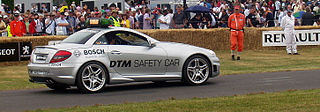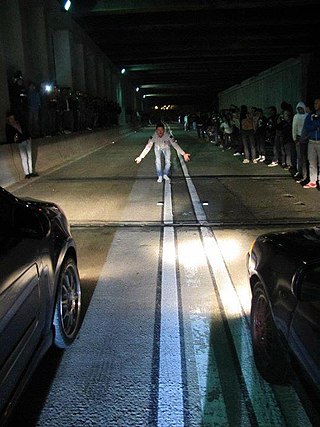
Drag racing is a type of motor racing in which automobiles or motorcycles compete, usually two at a time, to be first to cross a set finish line. The race follows a short, straight course from a standing start over a measured distance, most commonly 1⁄4 mi, with a shorter, 1,000 ft distance becoming increasingly popular, as it has become the standard for Top Fuel dragsters and Funny Cars, where some major bracket races and other sanctioning bodies have adopted it as the standard. The 1⁄8 mi is also popular in some circles. Electronic timing and speed sensing systems have been used to record race results since the 1960s.

Traffic lights, traffic signals, or stoplights – also known as robots in South Africa – are signalling devices positioned at road intersections, pedestrian crossings, and other locations in order to control the flow of traffic.

The National Hot Rod Association (NHRA) is a governing body which sets rules in drag racing and hosts events all over the United States and Canada. With over 40,000 drivers in its rosters, the NHRA claims to be the largest motorsports sanctioning body in the world.

A dragstrip is a facility for conducting automobile and motorcycle acceleration events such as drag racing. Although a quarter mile is the best known measure for a drag track, many tracks are eighth mile (201 m) tracks, and the premiere classes will run 1,000 foot (304.8 m) races. The race is begun from a standing start which allows three factors to affect the outcome of the race: reaction time, power/weight ratio, and traction.

Pinks is the primary television series in a franchise series of television programs on Speed based on street racing, held at legal closed drag strips with a theme around drag racing. The original aired from 2005 to 2008, with the spinoff Pinks: All Out following in 2006 until 2010. The name of the show, and the tagline "Lose the race – lose your ride", refer to common slang of pink slips representing a vehicle's title document recording ownership, and the derivative street-racing phrase, "racing for pinks," meaning a race in which the winner earns the loser's car.

Bracket racing is a form of drag racing that allows for a handicap between predicted elapsed time of the two cars over a standard distance, typically within the three standard distances of drag racing.

In motorsport, a safety car, or a pace car, is an automobile which limits the speed of competing cars or motorcycles on a racetrack in the case of a caution period such as an obstruction on the track or bad weather. The aim of the safety car is to enable the clearance of any obstruction under safer conditions, especially for marshals and/or await more favourable track conditions weather-wise. By following the safety car, the competitors' tyres remain as close as possible to operating temperature while their engines do not overheat. A safety car is also preferred over restarting the race as the latter takes longer.

Street racing is typically an unsanctioned and illegal form of auto racing that occurs on a public road. Racing in the streets is considered an ancient hazard, as horse racing occurred on streets for centuries, and street racing in automobiles is likely as old as the automobile itself. It became especially prevalent during the heyday of hot rodding (1960s), muscle cars, Japanese imports (1990s) and sports cars (2000s). Since then, it continues to be both popular and hazardous, with deaths of bystanders, passengers, and drivers occurring every year. In the United States, modern street racing traces its roots back to Woodward Avenue, Michigan, in the 1960s when the three main Detroit-based American car companies were producing high-powered performance cars. Since a private racing venue was not always available, street races would be held illegally on public roads.

A motor vehicle has lighting and signaling devices mounted to or integrated into its front, rear, sides, and, in some cases, top. Various devices have the dual function of illuminating the road ahead for the driver, and making the vehicle visible to others, with indications to them of turning, slowing or stopping, etc., with lights also indicating the size of some large vehicles.

Racing flags are traditionally used in auto racing and similar motorsports to indicate track conditions and to communicate important messages to drivers. Typically, the starter, sometimes the grand marshal of a race, waves the flags atop a flag stand near the start/finish line. Track marshals are also stationed at observation posts along the race track in order to communicate both local and course-wide conditions to drivers. Alternatively, some race tracks employ lights to supplement the primary flag at the start/finish line.
"Delay Box" is a common slang term used in drag racing to describe an on-board timer which is a Transmission Brake Delay Timer. A transbrake forces the race car to remain stationary at the starting line, in gear, regardless of how much engine power is applied. When the visual signal is given to start the race, the driver triggers the delay box to begin timing. If the driver does not interrupt this timing device, the car is launched down the race track at the instant the timer expires. Delay box use was very controversial in the 1980s and 1990s, as it removed a portion of the advantages more experienced racers had. There was a period where technologists added and concealed homemade circuitry inside a delay box that violated some racing associations rules. Racing associations have imposed strict limits on delay boxes today, with manufacturers having to submit to an approval process, which has drastically reduced the number of makers of these devices.

Maple Grove Raceway (MGR) is a quarter-mile dragstrip located near Mohnton, Pennsylvania, just outside Reading. It opened in 1962 as a 1/5-mile dragstrip. It was eventually lengthened to its current quarter-mile length in 1964. The track has been sanctioned by the National Hot Rod Association for most of its existence. It has hosted an NHRA national event since 1985. Uni-Select Auto Plus came aboard as the Nationals sponsor in 2011. Other key events include the American Drag Racing League, the NHRA Lucas Oil Drag Racing Series, the Geezers Reunion at The Grove, the Super Chevy Show, Mopar Action, Fun Ford Weekend and the NHRA Pennsylvania Dutch Classic.
The following is a glossary of terminology used in motorsport, along with explanations of their meanings.

The normal function of traffic lights requires more than sight control and coordination to ensure that traffic and pedestrians move as smoothly, and safely as possible. A variety of different control systems are used to accomplish this, ranging from simple clockwork mechanisms to sophisticated computerized control and coordination systems that self-adjust to minimize delay to people using the junction.
The 2012 NHRA Full Throttle Drag Racing Season was announced on September 8, 2011. The schedule was revised on October 12, 2011, with the events at Maple Grove Raceway and Gateway International Raceway swapping dates.
The 2015 NHRA Mello Yello Drag Racing Season was announced on August 25, 2014.
The 2016 NHRA Mello Yello Drag Racing Season was announced on September 5, 2015.

The European Drag Racing Championship is a combination of four Drag Racing categories that have competed in six events since 1996. The European Drag Racing Season is held from May to September in four countries; UK, Sweden, Finland and Germany. Each drag race category pairs two drivers that compete against each other and the winner is the racer with the lowest reaction time and elapsed time over a designated destination. The drivers are adjudicated points for their performance at each stage which are tallied for a given season.
The 2019 NHRA Mello Yello Drag Racing Season was announced on July 25, 2018.
The 2021 NHRA Camping World Drag Racing Season was announced on October 6, 2020.






























